SAINT LOUIS ZOO ASSOCIATION
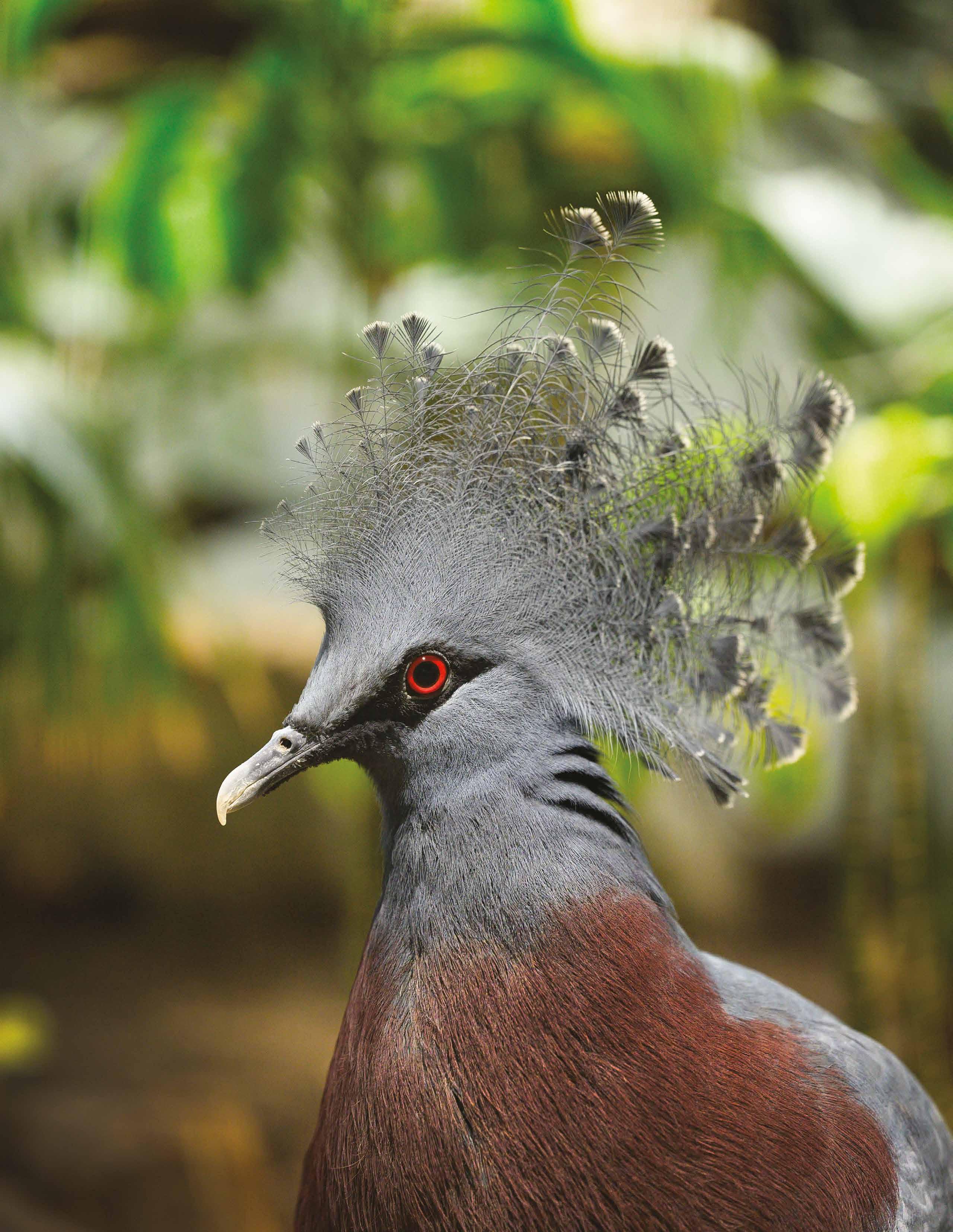
Fall 2023
Volume 39, N0.
of
of the Wild | Caring for Venomous Snakes
The Importance
Zoos | Learning the Ways
4
By Michael Macek, Director, Saint Louis Zoo
Fall is a beautiful time of year to visit the Zoo and connect with nature and animals. It also can be a great time to reflect. Reflecting is something we are doing a lot of in this issue of the magazine.
Our main article in this issue focuses on why zoos are important — our Zoo in particular. While zoos are an incredible place to connect with animals, be in nature and spend time outdoors with loved ones, they do so much more. Zoos help save species from extinction, inspire future scientists and environmental stewards, and connect people and animals in ways that have lasting impact. Zoos help people look at the world differently. This idea of our Zoo being more than a destination, but rather a way of looking at our world, is the inspiration for our new advertising campaign. The campaign launched this summer and we hope it inspires you to get a zoo perspective by appreciating the unique attributes of the animals in our care, and thinking about the world and your place in it differently. Explore why zoos are important on page 6 and check out one of our new “Get a Zoo perspective” ads on page 3
The fall season also has us reflecting on learning. Students are back in classrooms absorbing information from teachers and interacting with peers to inform their future selves. Our Zoo preschoolers are busy learning about their connection to the natural world, spending at least 50% of their time outside every day. Animals are learning each day, too, and it’s essential for their survival. From the knowledge adult elephants pass on to their young, to the changing hunting tactics of the jumping spider, animals have unique ways of adapting to their environment. Learn more on how a variety of animals learn in the wild on page 12.
On the topic of animals, there are some unique stories in this issue highlighting animals that may not always get the spotlight: snakes and snails! Follow the journey of some of our Animal Care team members as they work to conserve important species around the world. Gain understanding about how the team cares for venomous snakes — and their importance — on page 18. If slow and steady wins the race, then the Partula snail is on its way. For 30 years, dedicated team members have worked to care for these snails. Read about their reintroduction to Papehue Valley, Tahiti, on page 20.
This season is always action packed with some of our most beloved events. Join us starting Oct. 13 for Boo at the Zoo — our kidfriendly Halloween event. Don’t forget to shop holiday favorites at our Holiday Zootique on Nov. 10. Then, take a stroll under the lights at U.S. Bank Wild Lights starting Nov. 24. There are so many exciting events coming up — find out more on pages 22 and 23.
Thank you for your support of the Saint Louis Zoo. We look forward to seeing you soon and we hope this issue of the magazine helps you reflect on your own, unique zoo perspective.
COMMISSION OF THE ST. LOUIS ZOOLOGICAL PARK SUBDISTRICT
Chair
Cynthia J. Brinkley
Vice-Chair
Lawrence E. Thomas
Co-Treasurers
Chonda J. Nwamu
Lawrence E. Thomas
Immediate Past Chair
Winthrop B. Reed III
Commissioners
Karl A. Grice
Robert R. Hermann, Jr.
Jerald L. Kent
Robert F. O’Loughlin
Neal F. Perryman
Michael W. Riney
Peggy A. Ritter
Will R. Ross, MD, MPH

Carol A. Wilson
Open Position
Chairs Emeritus
Honorable James F.
Conway
Steven F. Schankman
Mark J. Schnuck
SAINT LOUIS ZOO ASSOCIATION BOARD OF DIRECTORS
President
Robert B. Smith III
Vice President
Michael J. Hickey
Treasurer
Lisa K. Sullivan
Secretary
Linda J. Hunter
Immediate
Past President
Alicia S. McDonnell
Executive Committee
Dr. Edmond B. Cabbabe
Kathy S. Federico
Matthew W. Geekie
Ricky L. Hopkins, Sr.
Annette L. Kelly
James P. Leonard
Dr. Matthew R.
MacEwan
Bhavik R. Patel
Dana Tucker Redwing
Angela D. Schaefer
Stephanie Valier
Schwendinger
Maria G. Taxman
Matthew A. Wagner
Gerald E. Wiley
James E. Williams, Jr.
Board of Directors
Barbara C. Archer
Kathleen W. Bilderback
Susan S. Block
Cenia D. Bosman
Christine Boushka
Debbie A. Caplin
Hazel Alethea R.
Donald
Edward Durham
Brad M. Edwards
Cory Elliott
Logan W. Finerty
Lauren Thomas Fries
Amy A. Gill
Brett G. Gilliland
Janis G. Goldstein
Davida Lichtenstein
Grindstaff
Kenneth H. Hannah
Charles Henson
Molly Hyland
Ryan L. Hyman
Robert F. Johnston
Carol S. Klein
Lee C. Kling
Judith B. Kouchoukos
Julie Lilly
Dr. Dan W. Luedke
Melissa Markwort
Ryan J. Martin
Jennifer T. McGrath
Andrew T. Miedler
Patrick J. Moore
John Nguyen
Dr. Stanley J. Niemann
Frances G. Pestello
Pravina Pindoria
Dr. Steven S. Pope
Quirsis V. Riney
James G. Sansone
Jason D. Sapp
Steven F. Schankman
James R. Schnurbusch
Shelley Seifert
Torbjorn B. Sjogren
Zachary A. Smith
John R. Sondag
Dianne Sutcliffe
Kevin Travers
James Tyrrell
Virgil Van Trease
Lottie Wade
Robert M. Williams, Jr.
Geoffrey Wilson
Heather Wood
Emerita – Emeritus Members
James G. Berges
Marguerite Garrick
Douglas E. Hill
Joseph F. Imbs III
John K. Wallace, Jr.
Ex-Officio
Whittney Dunn
SAINT LOUIS ZOO YOUNG ADVISORY BOARD
President Whittney Dunn
Secretary Rei Kato
Vice Presidents
Emily Carter
Betsy Crites
Samantha Hurrell
Christian Wargo
Luke Yamnitz
Treasurer
Brittany Mayfield
Liaisons
Jennifer Jeffries
Tre Moore
Mike Poletti
Megan Schwedtmann
Zach Ungerott
Eric Werner
Open Position
Open Position
Open Position
Board Members
Erica Agnew
Joel Carter
Jamal Cornelious
Justin Diecker
Katie Doherty
Allison Heininger
Bryar Keyes
Kelly King
Praveena Kolli
James Merenda
Timothy Nielsen
Lauren Parko
Dacoda Scarlett
Kate Schwarze
Kristin Shannahan
Kelly Stein
Alex Stepanek
Jake Thessen
Michael Tulley
Craig VanLeeuwen
stlzoo
All lists as of September 2023
PROFESSIONALS Commentary
In This Issue
2 Membership Updates
22 Happenings
29 Saint Louis Zoo Honor Roll

30 Saint Louis Zoo Tribute Fund
32 Kids Page
12
The Importance of Zoos
Explore how zoos help guests create incredible memories and help change our world.
18
Learning the Ways of the Wild Learn how animals adapt in the wild.
Caring for Venomous Snakes
Get the facts on the importance of venomous snakes.


On the Cover
Victoria crowned pigeon
stlzoo is published quarterly as a member benefit by the Saint Louis Zoo Association, One Government Drive, St. Louis, MO 63110 Permission to reprint any material is granted, provided proper credit is given.
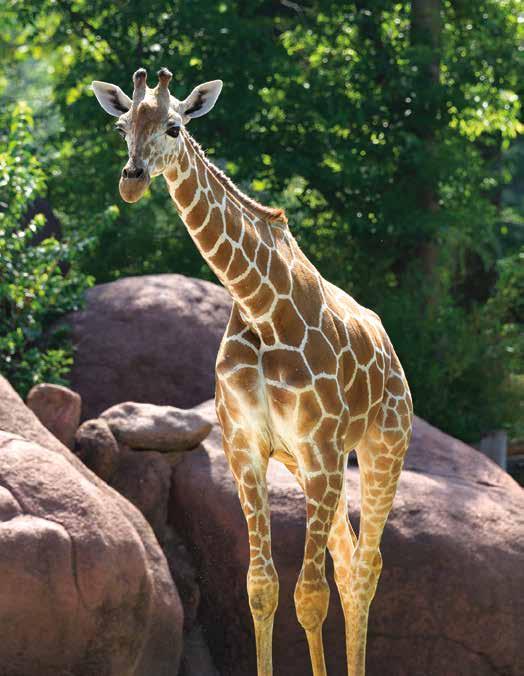
n Managing Editor: Rebecca McMiller
n Editorial Assistance: Billy Brennan, Jill Gordon, Kirby Meyer, Elaine Vydra
n Graphic Design: McCord Design Group
n Contributing Photographer: Ray Meibaum
n Contributors: Members of the Zoo staff
At the Saint Louis Zoo, we not only care about the conservation of animals, but also about the conservation of the environment. That is why stlzoo magazine is created using FSC- (Forest Stewardship Council) certified paper with recycled materials and eco-friendly inks. You also can opt into receiving digital-only issues! Check your email for instructions.
1 Fall 2023
6
Photo by Ray Meibaum
Central American bushmaster
Membership Updates
Hi, Zoo members! In this section, we’ll quickly highlight top Zoo happenings in October, November and December 2023, from event and attraction updates to member-specific reminders. If you have questions about your membership, please visit stlzoo.org/membership or contact us at (314) 646-4771, option 2.
Attraction Dates
Emerson Dinoroarus
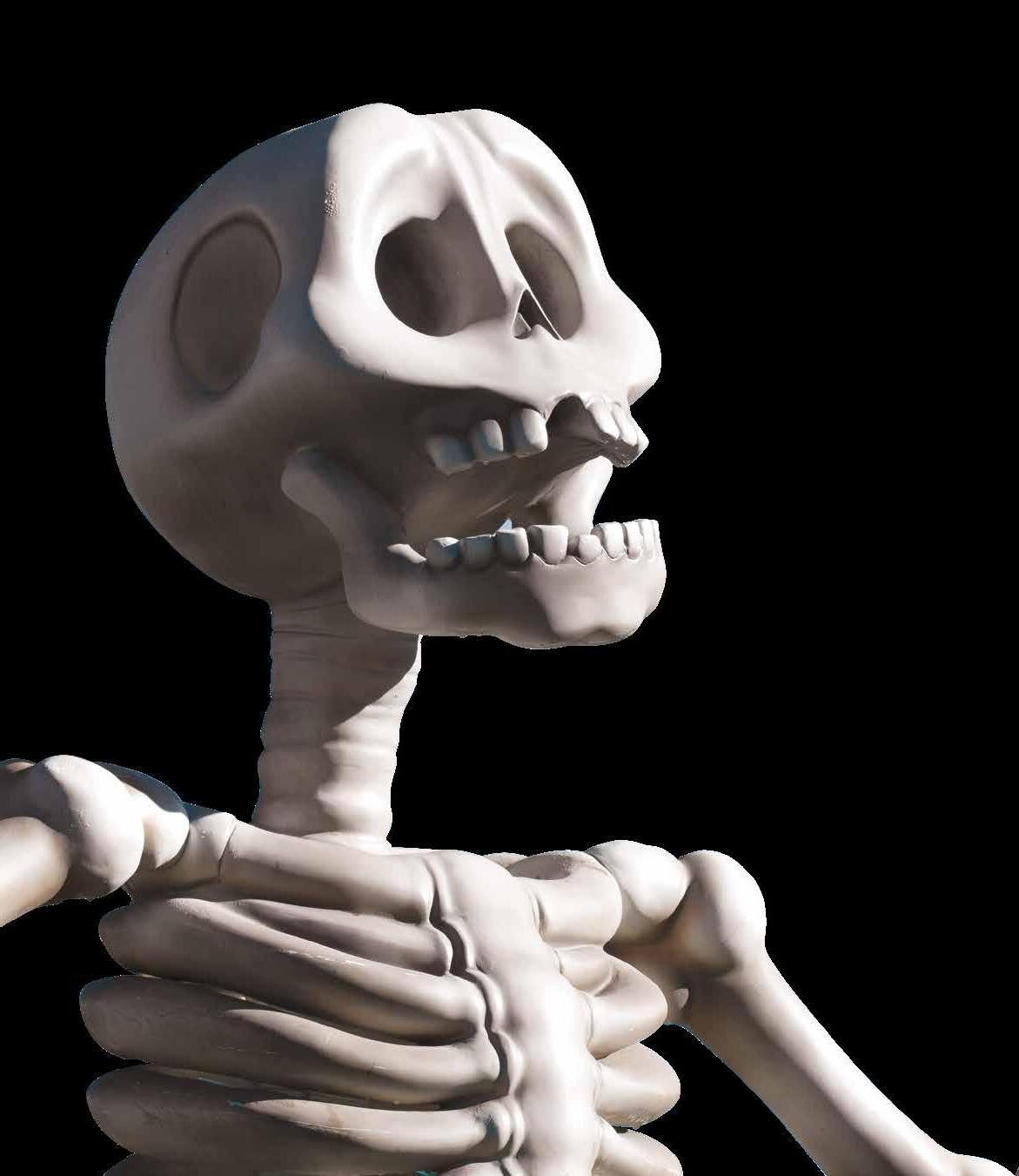
Open through Nov. 5
Included in member tickets
It’s our last year for this exhibit; hurry and see before it goes extinct!
Sea Lion Show Weekends only through Oct. 29
Included in member tickets
Stingrays at Caribbean Cove presented by SSM Health
Open through Nov. 5
Included in premium member tickets
Take advantage of member discounts at fall events!
Make your membership benefits count at Boo at the Zoo presented by SSM Health Cardinal Glennon Children’s Hospital and at U.S. Bank Wild Lights! Zoo members receive discounted admission to these beloved events, plus an additional 10% discount (20% total) in open gift shops during the events.


And don’t forget about Holiday Zootique on Friday, Nov. 10, where you can shop for one-of-a-kind gifts and enjoy an additional 10% discount % total). Plus, enjoy light snacks and beverages while you shop. Volunteers will be on hand to wrap gifts for you!
Learn more about these events on pages 22 and 23 and at stlzoo.org.
Looking for a great holiday gift idea?
Give the gift of membership. Each membership includes member tickets, free parking, a 2023 collectible holiday ornament and more.

Or maybe a Zoo Parents plush toy adoption package featuring the polar bear is just the perfect size. Best of all, your adoption contributes to the care and feeding of our animals for a full year.
Both are one-of-a-kind gifts that keep on giving. Learn more at stlzoo.org/membership.

stlzoo 2

Get a Zoo perspective. Plan your visit at stlzoo.org
Did You 1

Our Zoo sells a variety of items in our gift shops, from plush toys to fine collectibles. At Safari Gift Shop and Treetop Shop, you’ll find handmade products that have especially touching, personal stories. These goods are made by communities — oftentimes by women entrepreneurs — that coexist with wildlife. By viewing wildlife and their habitats as resources to
Gifts that Do Good
Tagua nut gifts and jewelry are an alternative to ivory. They also help preserve the rainforests since the nuts fall to the ground. Harvesting them does not damage trees.
Beadwork keychains help sustain the livelihood of women in the Lewa Wildlife Conservancy in Kenya. Proceeds also support conservation efforts of the Northern Rangelands Trust, a membership organization owned and led by 43 community conservancies in Kenya and Uganda.
Painted Dog Conservation
snare-art sculptures are created out of the very snare wire poachers use to trap painted dogs. The wire is removed from animal environmental systems and transformed into beautiful works of art.
Handcrafted sculptures and knitted goods support women in Ecuador’s workforce while also aiding in sea turtle conservation.
Kenyan wood and stone carvings are often made of locally sourced materials, helping crafters support themselves and their community.

Know...
Why Local Communities are Key to Saving Wildlife
As a conservation organization, it’s important that the Zoo cares for and strengthens humans and communities. Humans can be part of the solution to preserve the species, but only if other humans make that possible. Simple things — like buying products produced by small villages — have a positive effect on people and animals halfway around the world. And, most village crafts are made from natural and sustainable resources, compounding the positive
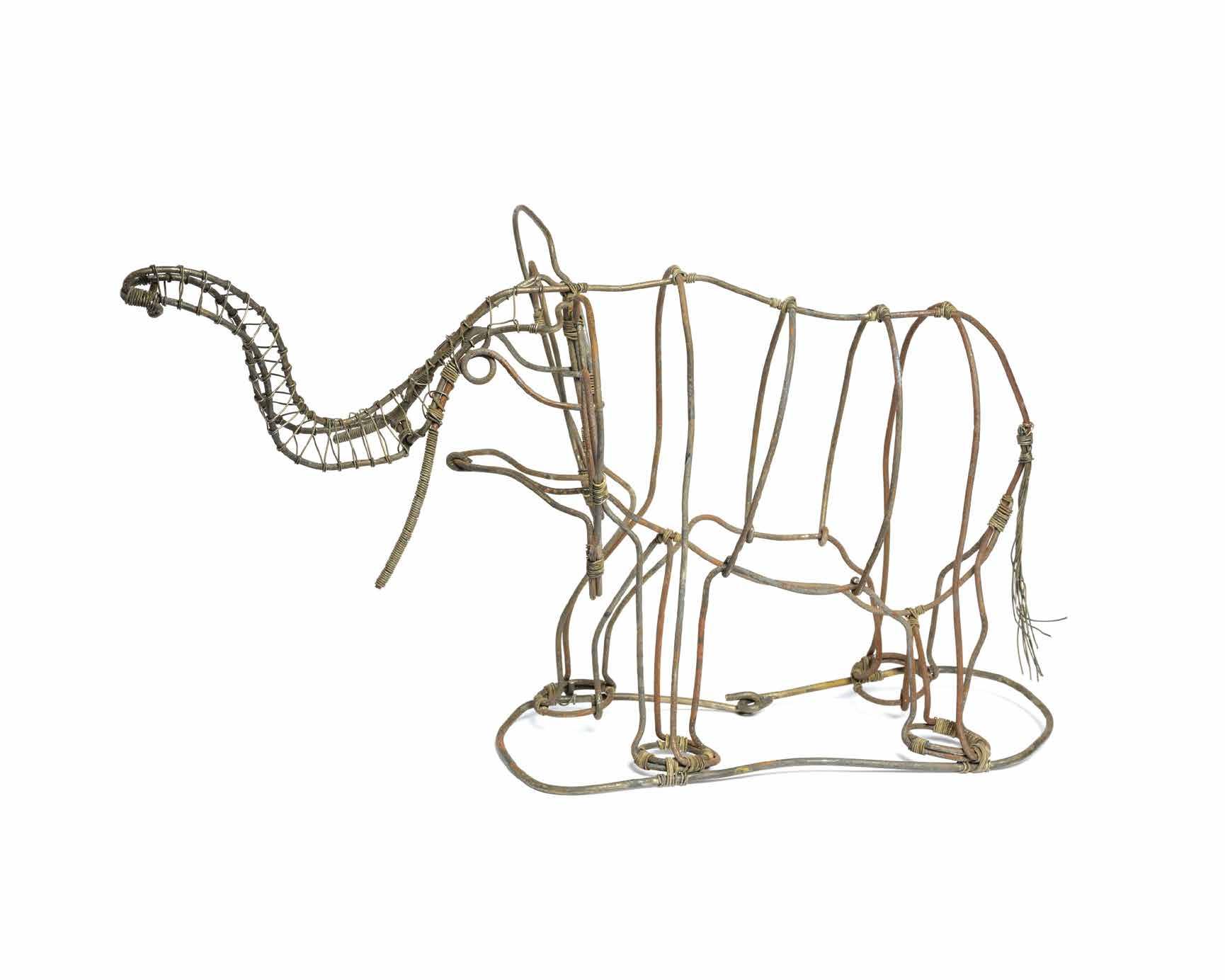

communities are part of the solution. Supporting communities through buying handmade, locally sourced products can help both people and animals thrive. Supporting women in business can help deter human trafficking and forced labor throughout the world. In some conservation organizations, supporting women workers also impacts conservation efforts. Research the products you buy to understand the consequence of your purchases. Our world and its inhabitants are worth saving, so it is important to buy items that support economic, environmental and social sustainability.
Shop for these unique gifts — and many more — at Holiday Zootique, the Zoo’s annual shopping event, on Friday, Nov. 10.

5 Fall 2023 2
LEARN MORE AT STLZOO.ORG
of Zoos Importance The
 By Regina Mossotti, Vice President, Animal Care
Photos by Roger Brandt and Ray Meibaum
By Regina Mossotti, Vice President, Animal Care
Photos by Roger Brandt and Ray Meibaum
I am often asked, “Why are zoos important?” It’s such a big question that I never know where to begin.
So, I will start with some quick history. Zoos as we know them have been around for nearly 150 years in the United States. They have undergone a constant state of evolution during that time to meet advances in animal care, working hard to ensure the well-being of every animal.
In the last few decades, accredited zoos have evolved further (and at a rapid pace), with the realization that they also are on the front lines of conservation. By understanding that what we do in our zoos is making an enormous difference for wildlife in countries all over the world, we have been able to make strategic and thoughtful decisions on where to put our resources to grow that impact. Our scientists, our keepers, our educators, our guest relations staff and so many others at our zoological institutions work tirelessly to care for our animals, share our stories and work to save wildlife and wild places. Every. Single. Day.
stlzoo 6


7 Fall 2023
Zoos as we know them have been around for nearly 150 years in the United States.
“
Above: Saint Louis Zoo WildCare Institute doing field conservation work
Below: Asian elephant
Zoos that are accredited members of the Association of Zoos & Aquariums (AZA) spend over $230 million annually on field conservation. This enormous contribution supports projects in over 130 countries and is working to save over 800 species. And, as a new member of the Saint Louis Zoo family, one of the many reasons I am so proud to have joined this Zoo is because of our significant financial commitment to conservation.
At the Saint Louis Zoo, our mission is steeped in conservation. You can see it in our incredible WildCare Institute, our Institute for Conservation Medicine, our innovative conservation education programs and more. We work globally, in Armenia and Madagascar and Peru — as well as locally, right here in Missouri (including in our very own backyard in Forest Park). We are releasing animals back into the wild to grow populations, discovering new models for protecting habitats, working with local communities to find ways to coexist with nature and so much more. As we do all this work to research and learn new ways that zoos can
have an impact on the lives and well-being of the animals under our care, we are sharing that knowledge and collaborating across institutions. This is to ensure that collectively we are making the best and most informed decisions when it comes to animal care, conservation and wildlife management.
All of that is big picture stuff. But, when I am asked why it is zoos are important, there’s an incredibly personal side that’s equally important: zoos provide a direct connection to nature.

And right now — as the most disconnected generations to have walked this planet — that connection is vital.
Americans spend much of their day connected to a computer, phone, tablet or TV screen. The United States Census Bureau found that approximately 80% of Americans in the United States live in an urban setting. Combine that screen time with the fact that more of us live in cities than ever before and it becomes clear that our connection to — and understanding of — the natural world is becoming increasingly more tenuous. This “nature” deficiency has a
stlzoo 8
“
Being in nature can make us happier and more physically resilient.
direct impact on our overall health. There is considerable research that shows how being in nature for a brief time — whether walking through a park or connecting with wildlife — can boost our physical, emotional and psychological health. Being in nature can make us happier and more physically resilient.

One of my favorite parts about visiting the Saint Louis Zoo with my family is exploring our native gardens and seeing the bees, hummingbirds and butterflies everywhere. Feeling directly connected to nature and including “nature” in our concept of self keeps us grounded and connected to the world around us. This extends beyond the borders of our zoos. I have seen how impactful these moments are for my children, too, especially when they asked their dad and me to plant the same native flowers in our yard, saying, “Mom, we have to help the bees!” And so, we did.
On top of this connection to our health, zoos work to increase our understanding of nature. When people don’t understand (or even fear) something, they’re far less likely to want to protect it.

When I taught at a university early in my career, part of my annual lesson in our Biology 101 course was to bring students into the woods near our classroom several times throughout the semester. Students would explore and learn about certain aspects of our ecosystem that corresponded with our lesson for the week. The most surprising aspect of this to me was that this up-close encounter was often unnerving for a lot of the students. And I saw this semester after semester, with each new
Many students in each class were afraid of touching plants, of picking up rocks to see what was underneath, of touching the water in the school lake, etc. For many, it was their first time being immersed in nature in an active and engaging way. For me, the most rewarding part of teaching this class was seeing the shift in my students during these outdoor experiences. Some would go from fear to curiosity to outright confidence and even excitement, which showed me just how quickly our perceptions can shift when we begin to interact with
9 Fall 2023

 Above: Guests feed the giraffes; Below left: Guests visit the Saint Louis Zoo; Below right: Victoria crowned pigeon
Above: Guests feed the giraffes; Below left: Guests visit the Saint Louis Zoo; Below right: Victoria crowned pigeon
I have seen this firsthand. Many of the conservationists and wildlife biologists I have met over my career have shared how zoos sparked that love of animals that led to a lifetime dedicated to saving wildlife. I, too, am a product of how compelling zoos can be.
As a native Saint Louisan, our Zoo was where I found my passion for wildlife. I remember vividly, one of the most impressive moments I experienced at the Zoo was when I met a real-life zookeeper for the very first time. I was 8 years old and thought I had just won the lottery.
In that brief encounter, she became my hero. I knew at that moment that I wanted to take care of animals like she did. And my parents continued to foster this passion as I grew by taking me out into nature often, to hike, to fish, to explore and to learn.
It was one moment, but its impact has lasted a lifetime. Every single day, this is happening in zoos around the world. Zoos know how vital this is. We know we are making a difference through our research, education and conservation efforts, but we also know we need our

Zoos are places where the stories of animals and nature truly take shape and come alive.
“
BY KIRBY EWALD, PUBLIC RELATIONS COORDINATOR
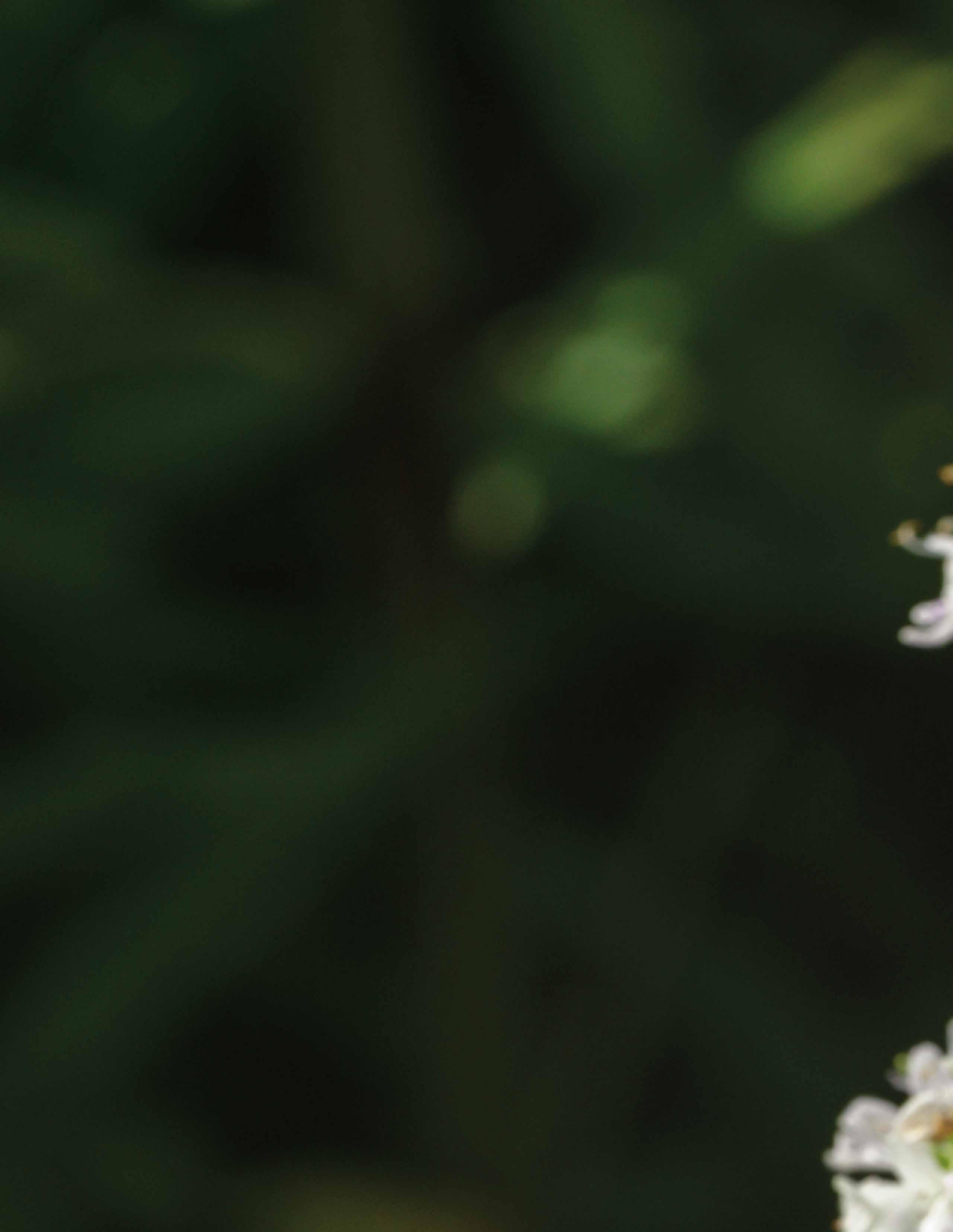 PHOTOS BY RAY MEIBAUM AND JOELLEN TOLER
PHOTOS BY RAY MEIBAUM AND JOELLEN TOLER
stlzoo 12
It’s hard to comprehend just how much children learn in the classroom. But as parents and guardians know, textbook education is just one part of what kids learn during their developmental years. As the saying goes, a child’s mind is like a sponge. (Though there are plenty of Zoo staff who would eagerly list significant differences between the porous members of the phylum Porifera and the brain of a juvenile Homo sapien, we all clearly see the logic in the comparison!)
Humans learn in exceptionally comprehensive ways. While students will hear about a variety of subjects from their teachers, they also may learn how to cooperate with their friends in class, practice decisionmaking on a sports team and watch how to prepare food from their parents. They may pick up on reading body language from an older sibling or realize the importance of taking a shower after playing outside.
Experiences as small as melting cheese for too long in a microwave play a role in providing children knowledge they will need as independent adults.
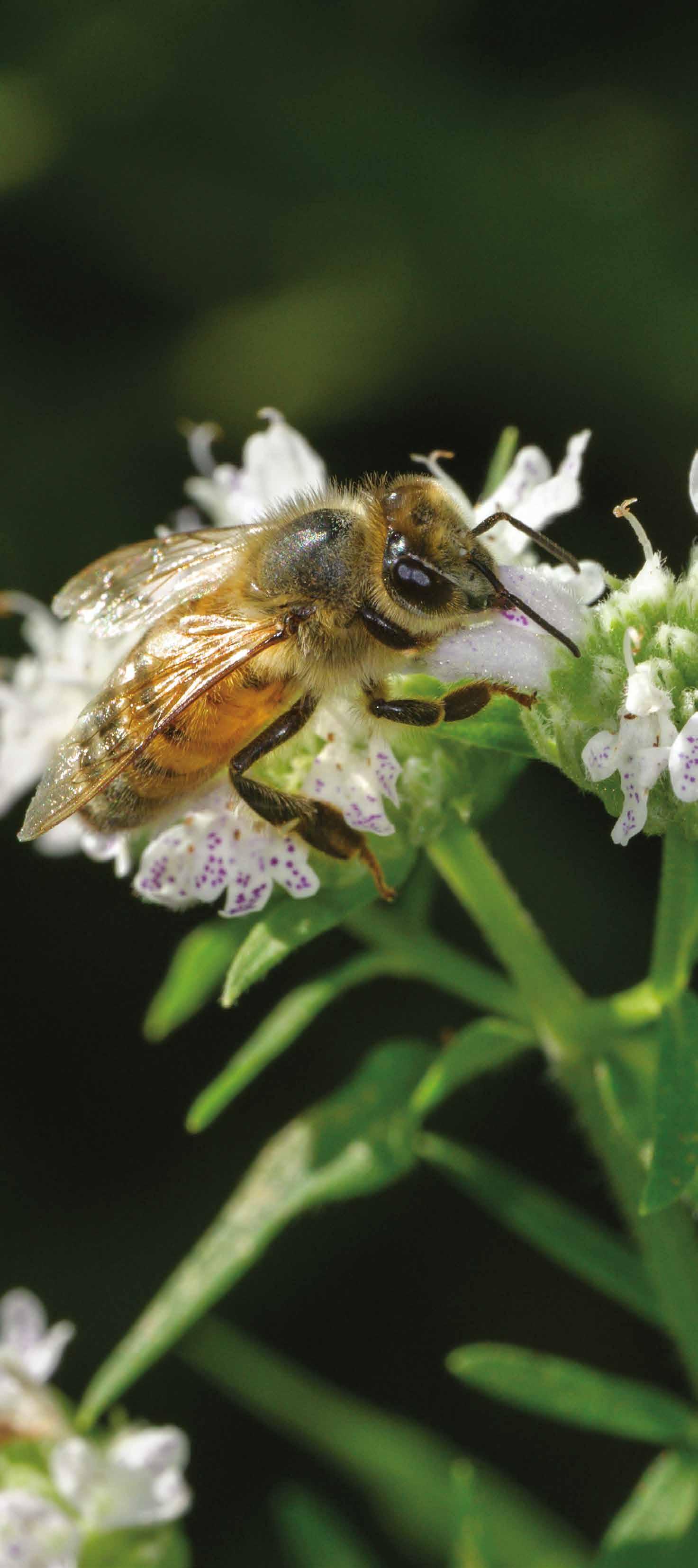
13 Fall 2023
Our constant and comprehensive learning begs the question of how animals learn in the wild. Scientists know a significant amount about the most exceptional cases of extraordinary learning. Elephants, the largest land animals in the world and often regarded as the most similar to humans in their comprehension and emotional complexity, teach a great deal to their young. The passing of knowledge from one adult elephant to a calf sometimes resembles formal training. An adult will show a young elephant how to find food, swim, and communicate with other elephants and animals, among countless other

life lessons. Another well-known example of purposeful teaching in the wild can be found in dolphins, a species that is second only to humans in its ratio of brain to body. With exceptional problem-solving skills and self-awareness, they have
been known to show others how to hunt, socialize and more.
But learning in the wild is not confined to complex mammalian brains. Some of the tiniest members of the animal kingdom have been known to be great tutors and pupils! It may not surprise you that honeybees are buzzing with fascinating adaptations that allow their colonies to thrive in complex ecosystems. Scientists have found that experienced honeybees teach younger bees how to communicate; specifically, how to perform a special type of dance to relay important information. This “waggle dance,” as it is often referred to, is performed by worker bees when returning to the colony as a way of relaying information about food sources.

stlzoo 14
ASIAN ELEPHANTS
“LEARNING IN THE WILD IS NOT CONFINED TO COMPLEX MAMMALIAN BRAINS.”
It is used between adult bees when sharing information about the details and location of food. In terms of needto-know, the waggle dance certainly beats out the Cha Cha Slide!
Bees are both a great example of active teaching (i.e., the purposeful passing of information from one individual to another) and passive learning. They have been known to choose their next pollen harvest by watching where other bees are busily swarming. This means they can learn

by observing others and deduce why some bees are choosing to fly around a certain area of vegetation. (There must be pollen there!) They are even able to take what they learn from others and improve upon it, showing that their little brains may be tiny, but their ability to teach, learn and adapt is an exceptionally valuable tool for their species.
The jumping spider is another animal that jumps off the cognitive learning charts. Unlike so many of its
eight-legged relatives, they choose to pursue their prey instead of building webs. Being intelligent, clever creatures, they often hunt what they know best: other spiders! Scientists have observed jumping spiders changing their tactics depending on the species — or even just the size — of the spider they are hunting. They plan attack paths and determine how to reach prey with the least risk. (Lowering onto a spider from above is often safer than crossing its web, for example.)

HONEYBEES ARE BUZZING WITH FASCINATING ADAPTATIONS THAT ALLOW THEIR COLONIES TO THRIVE IN COMPLEX ECOSYSTEMS.
“ ”
15 Fall 2023
HONEYBEE
Just like people, wildlife has a variety of ways of learning, often through observing their surroundings. Most animals learn, at least in part, from observation, even by watching animals outside of their family. This can be seen throughout the animal kingdom, including in the somewhat-rare Missouri resident, the Bewick’s wren.
Bewick’s wrens are small, highly vocal birds that live in southwestern Missouri during the summer. Their songs play a crucial role in their life and are essential for communicating with other birds. A young male Bewick’s wren will
learn its song not from its father, but from listening to neighboring males. He will pick his life song up before his first winter, while still living on his parent’s territory, and use it for the rest of his life.

Another example close to home can be found in the Bali myna, a species that lives in the Bird House at the Zoo. The Bali myna is a striking, slender white bird endemic to the Indonesian island of Bali. They are starlings, a family of birds that is known for being particularly chatty. A family-oriented species, both parents help incubate the eggs and raise the young. The chicks

stay with their parents for a month after hatching, all the while learning important life lessons from their mom and dad, such as what foods to eat to stay healthy and which trees make the best homes.
Most bird parents play some role in preparing their chicks for life without them, and their lessons may be more meticulous than you think. Many songbird species even teach dialects. This means birds from the same species that sing the same songs will make slight differences in their tune depending on what regions they are from. These dialects are passed down from one generation to the next.
“ ” stlzoo 16
MOST BIRD PARENTS PLAY SOME ROLE IN PREPARING THEIR CHICKS FOR LIFE WITHOUT THEM, AND THEIR LESSONS MAY BE MORE METICULOUS THAN YOU THINK.
BALI MYNA
But what about solitary animals, like many reptile species? Do they learn or is everything they need to know programmed from the moment they hatch?

Though coldblooded, reptilian parents aren’t coldhearted! From timber rattlesnakes to the spectacled caiman, there are countless examples of reptilian parents taking care of their young and acting as exceptionally dedicated parents to newly hatched offspring. But researching if and how reptiles learn from their parents and others is a new area of science.
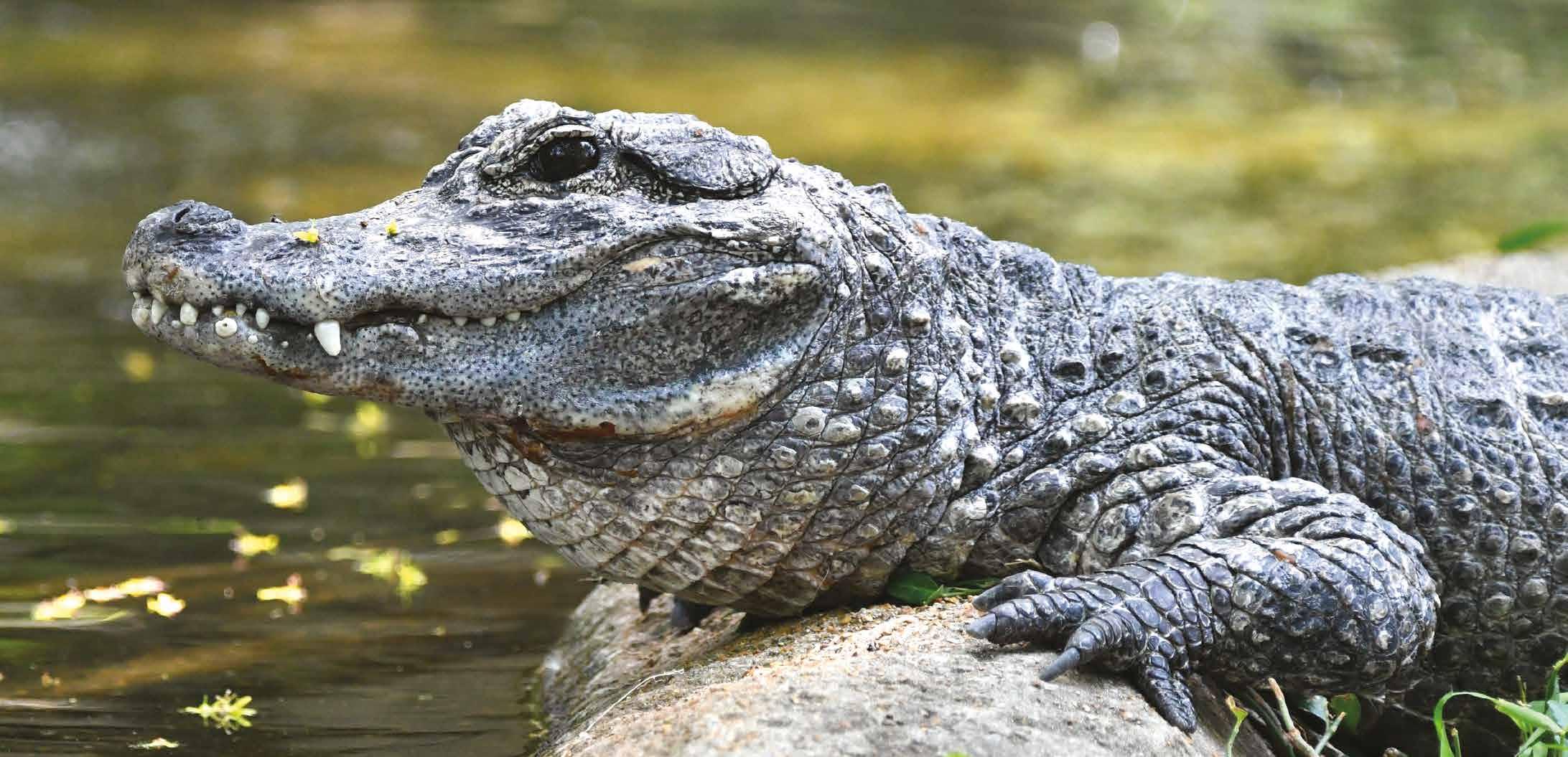
Although minimal exploration has been completed on this topic, we can extrapolate what we know about how reptiles learn from our experiences with these species in zoo settings.
Many of the animals that live in the Charles H. Hoessle Herpetarium have not only learned training techniques, but they even associate
certain staff members with those training exercises. Keepers see the highest rates of engagement with an animal when the appropriate keeper asks for the appropriate technique. For example, Chinese alligators at the Zoo may not participate in training when the keeper they work most closely with is on vacation. (And that’s okay! Training is always an optional activity for the animals at the Zoo.)
Many of the reptiles have been taught where they are fed, what they
are fed and when to move to a new space. They catch on easily and respond with impressive cognition to new tasks. In short, these solitary animals are exceptional students! Although we cannot say for certain that wild-living reptiles learn a great deal from their parents and others, Zoo staff believe it is highly likely and may be something humans will learn themselves in the future!
Learning is universal. It is a part of life and essential for the survival of all species. The way animals learn may differ and the lessons they learn may change, but all species can take in their environment and adapt.
So, if you know a student who goes to school nervous, let them know that they are taking part in a worldwide activity essential for animal life on Earth. Learning truly is a way of the wild! n
17 Fall 2023
CHINESE ALLIGATOR
Caring for Venomous Snakes
By Justin Elden, Curator of Herpetology & Aquatics
Of the nearly 4,000 snake species in the world, nearly 600 are venomous. Venom is especially useful for an animal with no arms or legs, allowing snakes to incapacitate prey and helping them to digest food before swallowing a meal. It also acts as a form of protection against the many predators that feed upon snakes.



The Saint Louis Zoo has a long history of introducing our guests to snakes from around the world, with an emphasis on venomous species. Whether it’s king cobras, bushmasters or Armenian vipers, all these animals act as ambassadors for snakes and their habitats in the Charles H. Hoessle Herpetarium.
Working with venomous snakes requires specialized knowledge in appropriate equipment and emergency preparedness to ensure staff, guests and the animals are safe. When it comes to being prepared, nothing helps with this more than snakebite drills. Venomous snakebite drills are required to be accredited through the
Association of Zoos & Aquariums (AZA). At the Herpetarium, we have no less than four Zoo-wide drills a year as well as a few dozen internal department drills. These ensure our “herp” keepers — as well as general Zoo staff — are prepared to act if there were to be a venomous snakebite.
keeping them at a safe distance from herp staff. The most widely used tool is the snake hook. We have over a dozen different types of hooks in our department for a variety of different sized and shaped species. After herp keepers show they can use these tools safely, they may begin their formal venomous training.
We take venomous training very seriously, and our herp keepers must show they are proficient with proper tools on non-venomous, harmless snakes before they begin training with venomous species. We use a variety of specialized equipment to minimize risks when working with venomous snakes, such as snake hooks, snake tongs, snake tubes and locking shift containers. Snake hooks and tongs are used to gently move the snakes,
As part of their training, herp keepers learn about subjects such as venomous snake behaviors and identification techniques. They learn about different species of venomous snakes, their natural habitats, venom composition, antivenin requirements and defensive behaviors. This knowledge is crucial for understanding how to interact with these animals safely. If a keeper has never worked a venomous snake before, it may take a year or more of intense training until they are prepared to work with species that are considered most challenging.
Once keeper staff are formally cleared to work with venomous snakes,
stlzoo 18
Timber rattlesnake
Ocellated mountain viper
A herp keeper uses a snake hook and snake tube to capture an Armenian viper
Zoo ALIVE Teens Take Conservation Action Virtual
they follow incredibly strict safety protocols. For example, there must be two fully trained keepers in the Herpetarium in order for snakes to be cared for at any time. This means there requires a tremendous amount of communication and coordination for scheduling, such as when staff leave for lunch breaks or off-site meetings. Another example of our safety culture is peer lockchecks. Keepers are assigned lockcheck partners daily. Partners ensure their locks and habitats are secured as secondary precautions. When it comes to our snakes’ habitats, they are designed and maintained to prevent escapes and protect both the snakes and the keepers. Daily inspections ensure any potential vulnerabilities are identified and addressed immediately.
Along with all these safety measures, we also have antivenin on-site for every species in our collection, provided such an antivenin is produced and available. Getting antivenin requires permission
through various government agencies and coordinating with antivenin labs around the world. We have special consultants we work with to help acquire antivenin as well as to help with venomous snakebite treatment plans.

Having venomous snakes at the Zoo is a tremendous amount of work, but having these animals in accredited zoos serves several important purposes. As an example, having venomous snakes in zoos — especially native, local species — allows for public awareness about snake safety and responsible interaction, reducing potential human-wildlife conflicts and snakebite incidents. Zoos provide a controlled environment where visitors can learn about venomous
snakes’ unique adaptations, behaviors, and the vital role they play in their ecosystems. This knowledge fosters understanding and appreciation, encouraging people to support conservation efforts for these often misunderstood and endangered species. Some of the most endangered reptiles on the planet include venomous snakes, like the mountain vipers of Western Asia. The Saint Louis Zoo WildCare Institute Center for Conservation in Western Asia team has been working with mountain vipers in Armenia for over a decade, helping to protect their habitats and implement conservation management practices. Through the work we have carried out in Armenia, we have helped to get formal protection for vital viper habitats throughout the country.
Whether you are terrified of them or can appreciate them from a safe distance, venomous snakes are incredibly important, and we are excited to share them with you. n
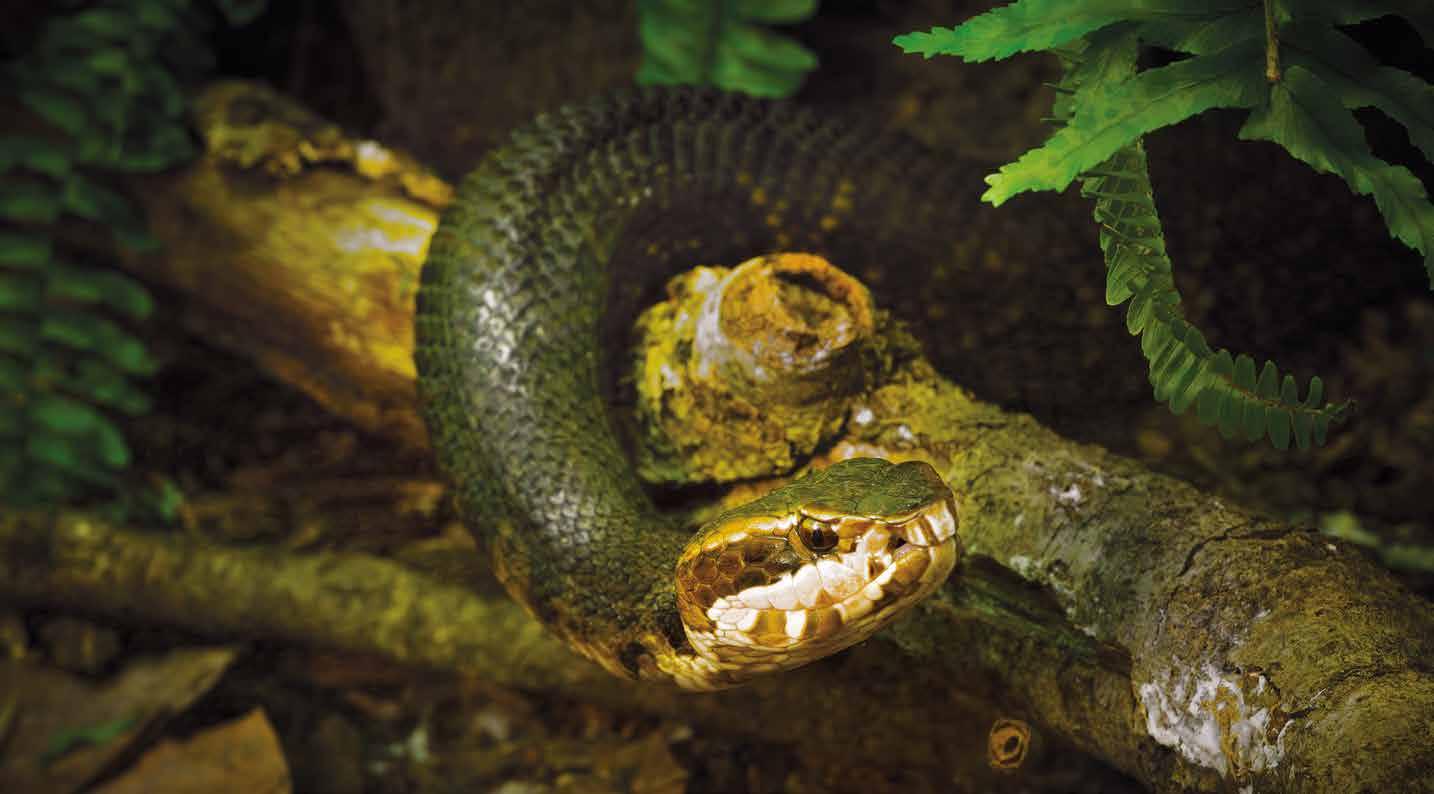
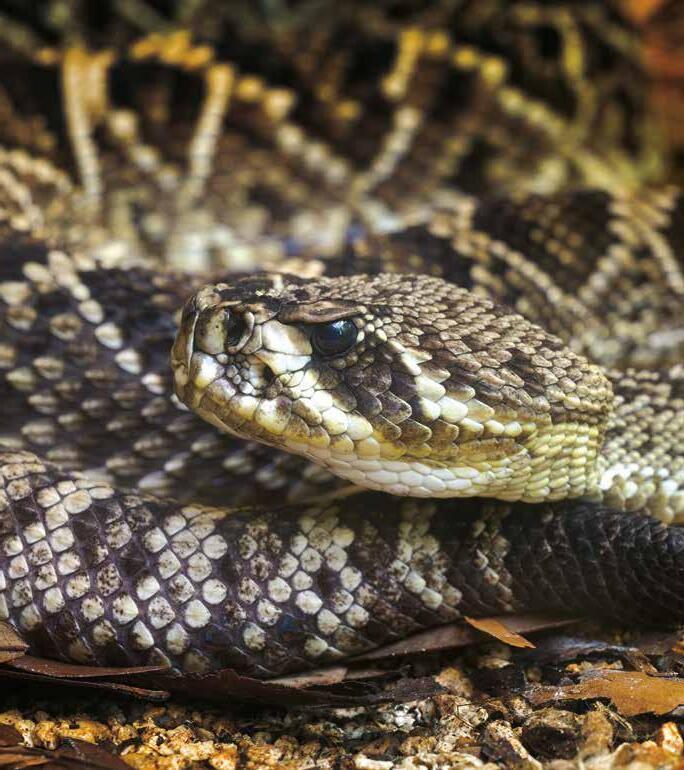
19 Fall 2023
Habu pitviper
Cottonmouth
Eastern diamondback rattlesnake
Paradise Found: Partula Snails Return Home to Tahiti
 By Kayla Garcia, Zoological Manager, Invertebrates
By Kayla Garcia, Zoological Manager, Invertebrates
Ten years ago, if someone had told me I would find myself spending an entire night watching snails in the middle of a Mo’orean forest, I would have laughed in disbelief.
Imagine my surprise to not only be doing that very thing this past spring, but to also spend two weeks in the tropical paradise that is French Polynesia. Not for a luxurious vacation or a honeymoon, like the couple sitting next to me on the plane from Los Angeles to Pape’ete. But rather, to participate in a reintroduction project 30 years in the making.
In the late 1980s, scientists studying the more than 50 species of Partula snails in French Polynesia raised a desperate alarm: entire species were vanishing before their eyes. The culprit? A non-native snail purposely introduced to combat another deliberately introduced snail. The rosy wolf snail vastly preferred the dime-sized Partula over the giant African land snail, their intended target. Those concerned scientists spearheaded a rescue mission in 1987 to save what species they could from extinction.


One species, Partula nodosa, has called the Saint Louis Zoo home since 1991. Zoos and universities have been their refuge since that initial rescue mission. The species is officially considered “extinct in the wild.”
For close to 30 years, a dedicated group of staff and volunteers has cared for these snails at the Zoo, carefully moving the tiny babies to clean containers and counting the entire population monthly. Fittingly, Partula snails get their common name from a Roman goddess of childbirth. They reproduce slowly, incubating eggs inside their bodies and giving birth to one baby snail every few weeks. This, however, was one of the factors that helped spell their doom, as there was no way to replace the snails lost to the voracious appetite of the rosy wolf snail.
From Refuge to Reintroduction
As zoos continued to safeguard
Partula species in their care, conditions were finally improving back in their native French Polynesia. The once feared rosy wolf snails declined significantly, probably because they ate most of the remaining Partula. It was those bittersweet conditions that made my trip in April reality: The fifth reintroduction of P. nodos since 2015!
While our registrars and animal health teams made sure all permits and health screenings were in place, our animal care team was ready to pack the snails up for their international journey. I flew ahead of the snails to prepare for their arrival.
This year’s reintroduction was broken up into two parts.
stlzoo 20
(The quarantine facility we used to care for the snails’ pre-release was quite small and could only accommodate around 2,500 snails.) Snails from Europe were scheduled to arrive first. The snails from the United States (from both Saint Louis Zoo and Detroit Zoo) would arrive a week later. The reintroduction team consisted of staff from London Zoo and Edinburgh Zoo, a Partula expert from Cambridge University, local government biologists, as well as members of their families and the local community.
After an eight-hour flight, I landed in the capital at about 10 p.m. Thankfully, our Tahitian colleagues were more than accommodating and spoke much better English than I did French. During my time in French Polynesia, I was able to visit three different islands: Tahiti, Raiatea and Mo’orea. Each island was formerly home to different species of Partula.
I spent two days in Raiatea accompanying biologists on a scouting mission to identify suitable release sites for future reintroductions. (I can confidently say that Missouri hiking did not adequately prepare me for the steep inclines of a volcanic island, crisscrossed by many slippery streams with plenty of moss-covered rocks and logs.)
Both reintroductions involved hiking to the right release site and
carefully attaching a plastic pot filled with snails and moss to the trunk of a tree. A total of seven species were released: four on Mo’orea and three on Tahiti.
This year, we tried something new and painted every single snail with a special fluorescent paint that glowed under ultraviolet light. This allowed us to track the tiny snails in the dim conditions of the undergrowth with UV flashlights. The biologists were quite curious to track the snails’ movements in the first 24 hours, so a few of us committed to staying up all night to document their dispersal.
The Partula snails from Saint Louis Zoo and Detroit Zoo
were released into Papehue Valley, Tahiti, the same location where the original founding snails were collected in that rescue mission more than 30 years ago.
To directly participate in returning a species to the wild is an almost indescribable feeling. It’s the culmination of many years of hard work of so many individuals who have dedicated their lives to saving the smallest animals in need. I couldn’t be prouder to represent the Saint Louis Zoo in our ongoing commitment to Partula, and I look forward to a world where they may once again thrive in their paradise homeland. n
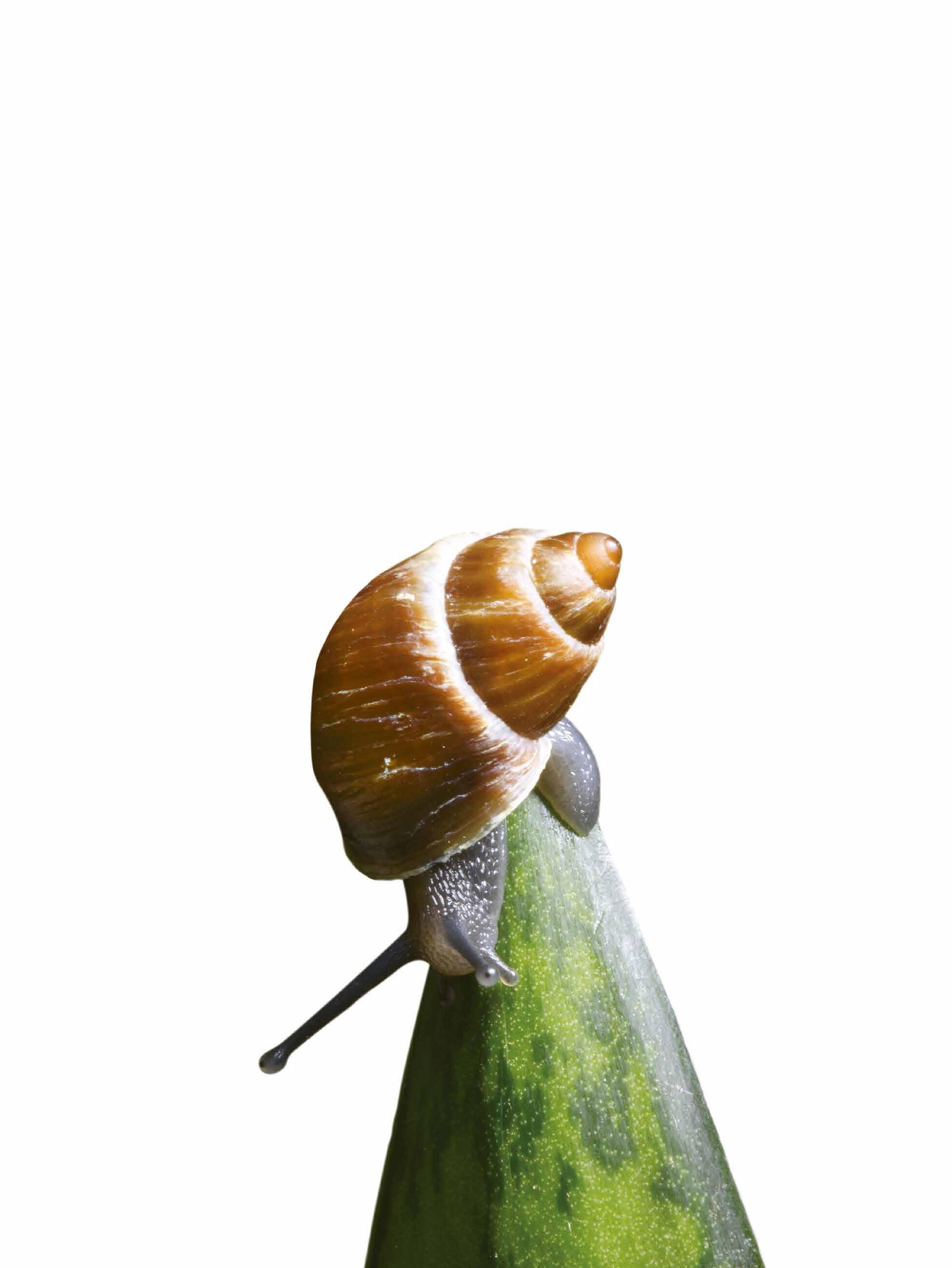
21 Fall 2023
Partula snail
Zootoberfest
happenings
Sept. 30, Oct. 1, 7, 8, 2023; 10 a.m. to 4 p.m.
Check out family-friendly Oktoberfest festivities with some Saint Louis Zoo flair! Each weekend, guests can hear German-themed music and enjoy special menus and seasonal drinks for purchase. Sponsored by Together Credit Union and Urban Chestnut Brewing Company. Free.
Boo at the Zoo presented by SSM Health Cardinal Glennon Children’s Hospital
Oct. 13-29, 2023; 5 to 8:30 p.m.; NEW! Sensory-Friendly Night is Oct. 16, 2023
Join us for the Zoo’s non-scary, kid-friendly evening Halloween event. Sponsored by SSM Health Cardinal Glennon Children’s Hospital, Wells Fargo, Caleres, Mid America Chevy Dealers and Prairie Farms Dairy. Purchase advance tickets at stlzoo.org. Zoo members: Oct. 13-15: $12; Oct. 16-19: $10; Oct. 20-29: $12. Children under age 2 are free.
World Reptile Day

Oct. 21, 2023; 10 a.m. to 2 p.m.
Learn about reptiles, the threats they face, and how we can help them. Free.
Sea Lion Show
Through Oct. 29, 2023; Saturdays and Sundays; 11 a.m., 1 and 2:30 p.m.
Sea lion superstars will thrill you with jumps and lots of splashing! Shows will be held at the Lichtenstein Sea Lion Arena, which features an 811-seat amphitheater for seasonal
LAST SEASON! Emerson Dinoroarus
Through Nov. 5, 2023
Come see this exhibit before it goes extinct! Throughout Dinoroarus, discover the amazing connections between dinosaurs and modern-day living animals while walking among 14 different groupings of animatronic and stationary dinosaurs. Dinoroarus also features hands-on opportunities for digging and play! Sponsored by Emerson and The Goddard School. Zoo members: Included in member/premium member tickets. Children under age 2 are free. After Nov. 5, Dinoroarus will close in preparation for the Henry A. Jubel Foundation Destination Discovery, our new experience for children and families.
Stingrays at Caribbean Cove
presented by SSM Health
Through Nov. 5, 2023
Guests can enjoy a hands-on opportunity to touch and feed these gentle ocean creatures. Zoo members: Included in premium member tickets.
stlzoo 22
Tree frog
happenings
Build First-Aid Kits at the Zoo Thursdays through Nov. 2, 2023; 9 a.m. to 2 p.m.
St. Louis Children’s Hospital will be at the Zoo helping young guests build first aid-kits. Stop by the St. Louis Children’s Hospital First Aid Station (near the Mary Ann Lee Conservation Carousel). Free.
Holiday Zootique
Nov. 10, 2023; 9 a.m. to 8 p.m.
Get a jump on holiday shopping! Zoo members receive special discounts. Free.

Zoo Dunnit? A Mystery Dinner
Nov. 11, 2023; 6 to 9 p.m.
For adults 21 and older only, come to the Zoo for a special interactive mystery dinner, featuring a threecourse meal and two drink tickets (to be used for beer, wine or specialty cocktails). Detective or sleuth costumes are encouraged; however, costume masks and face paint are prohibited. Please check stlzoo.org for pricing. Free parking. More info: (314) 646-4897.
U.S. Bank Wild Lights
Nov. 24-26, 29-30, Dec. 1-3, 7-10, 13-23, 26-30, 2023; 5 to 8:30 p.m.; Sensory-Friendly Night is Dec. 11, 2023
Enjoy the Zoo decked out for the holidays! Sponsored by U.S. Bank, Spire, Coca-Cola, Mid America Chevy Dealers, Prairie Farms Dairy and Truck Centers, Inc. Please check stlzoo.org in November to purchase tickets. Children under age 2 are free.
Breakfast with Santa
Dec. 2, 3, 9, 10, 16, 17, 2023
Festive holiday breakfast buffet includes a photo opportunity with Santa, a gift for kids and visits from costumed characters. Pre-paid reservations are required, and seating is limited. Please check stlzoo.org for pricing. Children under age 2 are free. Free parking. More info: (314) 646-4897.
Wild Lights admission is included in Dinner with Santa reservations (weather permitting). Please check stlzoo.org for pricing. Children under age 2 are free. Free parking. More info: (314) 646-4897.
Hours
Through Oct. 11, 2023
9 a.m. to 5 p.m.
Oct. 12 to Dec. 30, 2023
9 a.m. to 4 p.m.
Labor Day Weekend (Sept. 2-4)
8 a.m. to 6:30 p.m.
Note: The Zoo closes early for select events and holidays. The Zoo is closed on Dec. 25. Visit stlzoo.org/hours for more information.
Details are subject to change. Please visit stlzoo.org for the latest information.
23 Fall 2023
Building One Health Education
By Keri Lammering,
Over the last two decades the planet has experienced a dramatic loss of both animal and plant species, endured the effects of climate change, and is still recovering from the worst pandemic in over 100 years.
If nothing else, the past three years adjusting to COVID-19 have shown us that our health is inextricably linked to the health of animals, the environment and humans around the world. This concept is a growing field initiative known as One Health. Although One Health courses (and even majors) are increasingly offered in higher education, there remain few One Health education opportunities at the K-12 level. In 2022, the Saint Louis Zoo received a federal Institute of Museum and Library Services (IMLS) grant to build One Health education programs in school districts in north St. Louis County.
Members of the Saint Louis Zoo Institute for Conservation Medicine
Liaison
(ICM) and Education teams collaborated with teachers and student interns within the Hazelwood and Ferguson-Florissant school districts to develop a three-week One Health unit that focuses on a current One Health issue relevant to those living in St. Louis County. The first round of student interns from both districts selected environmental racism as their One Health topic, and they led group discussions with their classmates.
Interns Toni Smith and Jaylen Gregory continued their One Health journey as ICM summer interns focused on the St. Louis Box Turtle Project. When asked about her favorite part of the internship, Toni smiled and said, “There are a few parks around my home, but not a lot of natural spaces, so going turtle tracking in Forest Park got me outside and I got to explore nature.”


Toni is an animal lover at heart, so it’s no surprise that she loved assisting with health checks.
Over the next couple of years, the Zoo plans to expand this One Health Education program into other school districts in north St. Louis County. We look forward to building strong connections between human health and the health

stlzoo 24
Conservation Education
Dr. Sharon Deem mentoring IMLS summer intern, Toni Smith
Toni Smith tracking turtles in Forest Park
Boeing Supports Nature-Based Education for Ferguson-Florissant
Students
By
The Boeing Company, a global leader in aerospace technology, has consistently demonstrated its commitment to making a positive impact beyond the skies. Through its longtime partnership with the Saint Louis Zoo, Boeing has played a vital role in fostering environmental conservation and STEM education, as well as helping to support the Zoo as a world-class destination for families to connect to nature. Boeing has been a dedicated philanthropic partner, contributing an impressive $3.95 million to the Zoo since 1984.
The generous contributions from Boeing have provided essential support for a wide range of initiatives at the Zoo. These initiatives have included the development and enhancement of exhibits, conservation programs, educational outreach and research efforts. With Boeing’s support, the Zoo has created engaging and immersive experiences for guests while promoting conservation efforts worldwide.
Chris Bray and Monique N. Bynum lead the Boeing Global Engagement efforts in the Central Region. Together, they ensure that the Boeing Company has a positive impact on the St. Louis area by creating partnerships with schools, nonprofits and community organizations.
Bray and Bynum also encourage links between The Boeing Company and its philanthropic partners whenever possible. Boeing employees have previously participated in volunteerism here at the Zoo, helping to refresh animal habitats in Red Rocks.


This year, Bray and Bynum have rolled out an exciting new philanthropic strategy, underscoring Boeing’s commitment to the local community and education. With a focus on the Ferguson-Florissant School District (located near Boeing’s St. Louis headquarters), the company aims to make a significant impact on the lives of young learners and inspire future STEM careers in science, technology, engineering and math.
This shift aligns with the Zoo’s evolving priorities. Saint Louis Zoo WildCare Park, which has a target public opening of 2027, will offer hands-on educational experiences that only nature can provide. While WildCare Park is still in the early stages of construction, the Zoo is already in conversation with FergusonFlorissant students and educators about the future programming that will be held there. The Ferguson-Florissant School District has participated in focus groups, listening sessions and surveys, providing valuable input for the Zoo Education team as WildCare Park is designed.
The Boeing Company and the Zoo share a commitment to STEM education and protecting the environment. With so much on the horizon, there is no doubt that this partnership will continue to produce transformative outcomes, cultivating a talented pool of future professionals who will contribute to the advancement of science. n
25 Fall 2023
Rachel Anders, Manager, Grants and Major Gifts
Boeing employees feed giraffes browse Boeing employees volunteer at Red Rocks
William F. Siedhoff
William “Bill” Siedhoff has a heartfelt passion for assisting children, families and others in need of help and a lifelong love of the Saint Louis Zoo. A favorite memory at the Zoo was the opportunity to spend time up-close with Raja, the first Asian elephant born at the Zoo, to celebrate his first birthday. He and his sister, Diana Natalicio, made many childhood memories at the Zoo — something they enjoyed for decades. Whether age 8 or 80, they felt the awe and timeless inspiration of the natural world as they immersed themselves in the Zoo’s flora and fauna.
Following a more than a 40-year career devoted to social services following his graduation from Washington University, Bill continues to find ways to
help people, particularly those in the city of St. Louis. “I have spent my whole career trying to help kids, families and others — not only meeting basic needs and preventing crises, but also providing opportunities to learn and have fun,” Bill says. “The Zoo is a place where families can spend time together connecting with nature. Being free to all makes the Zoo accessible and welcoming to all people, offering an enriching experience that lasts a lifetime. I feel good about supporting the Zoo, through a provision in my estate plan as well as endowing a permanent fund that fulfills my wish to benefit others for generations to come.”
In addition to the Zoo, Bill supports many organizations as a volunteer leader on several
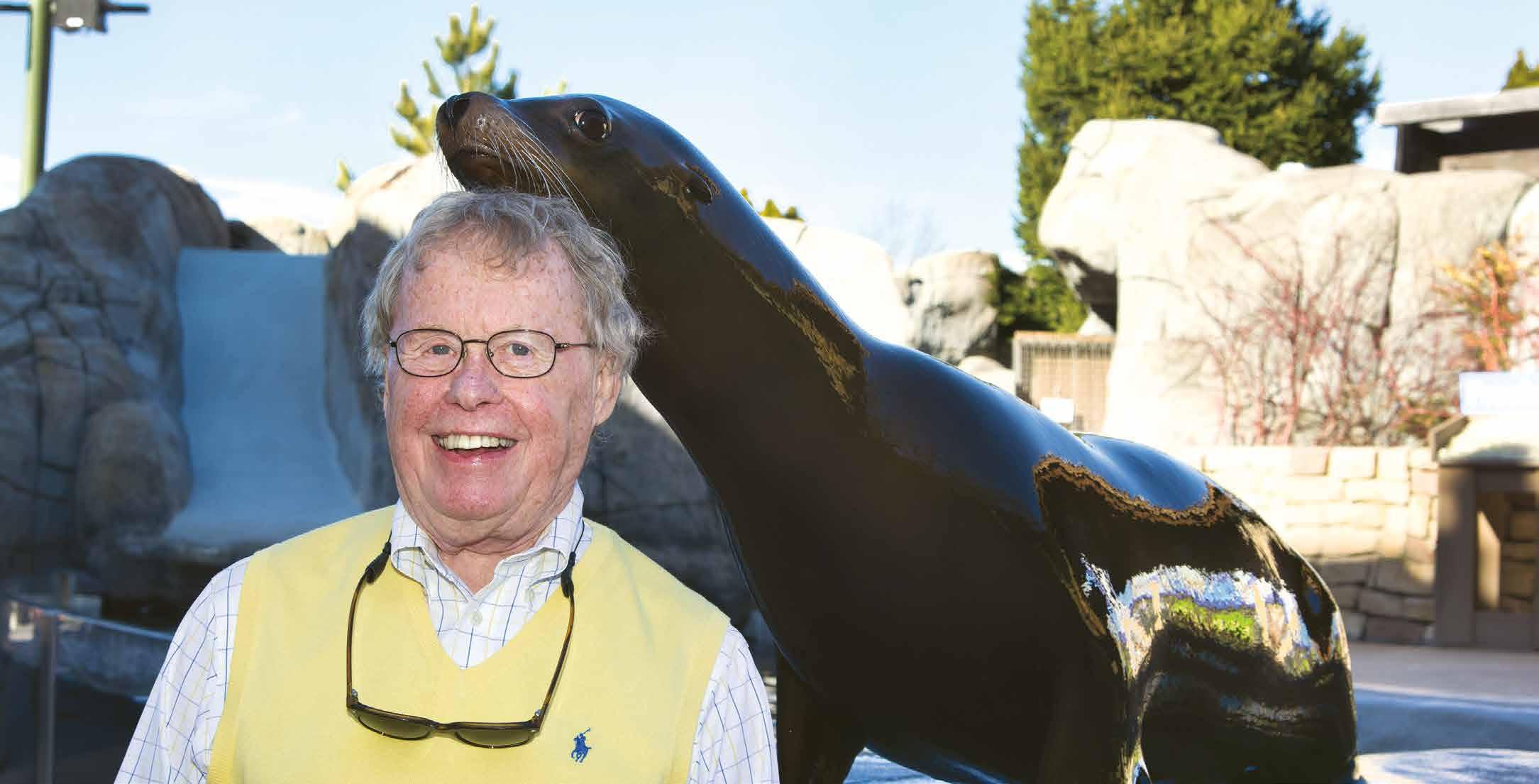
boards and committees as well as through the William F. Siedhoff Foundation that he established, dedicated to improving lives in our community. He serves as Chair of the Board of Developmental Disability Resources, the St. Louis Senior Fund, St. Louis Crisis Nursery, and the Education/ Government Division of the United Way Campaign. He also serves on the Brown School National Council at Washington University and the Danforth Circle Eliot Society Committee. These organizations, along with the Saint Louis Zoo, count
Bill Siedhoff among their blessings — a single person whose leadership, efforts and generosity help make good things happen in people’s lives today as well as tomorrow. n
stlzoo 26
Bill Siedhoff meeting a California sea lion Lori A. Sullivan, Director, Planned Gifts
ZOOFARI 2023 – A Giraffe Jamboree
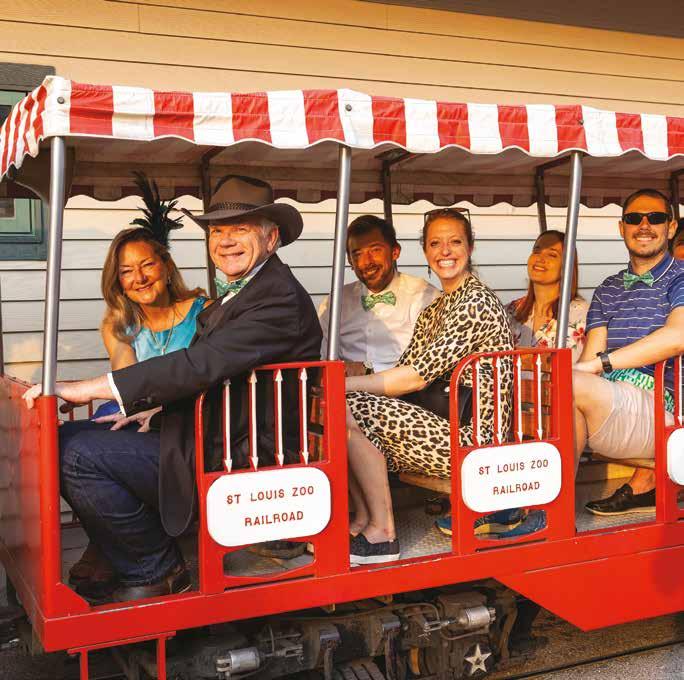 By Hannah Stater, Partnership Marketing Coordinator
By Hannah Stater, Partnership Marketing Coordinator
On the cool summer evening of June 16, more than 2,500 Zoo supporters came together for ZOOFARI 2023 presented by Wells Fargo. In celebration of our featured animal, the reticulated giraffe, we were able to raise $745,000, supporting our mission of conserving animals and their habitats in the wild.
We welcomed over 40 St. Louis restaurants that served delicious sweet and savory dishes across the Zoo.

Under the starry sky, event attendees sipped refreshing drinks and listened to live music from the evening’s main stage entertainment — The Downtown Band. Guests also enjoyed special fundraising activities, including the Kendra Scott Color Bar™, wine and spirits pulls, bourbon tasting from STL Barkeep, a silent auction, and a local restaurant gift card wall funded by Wells Fargo.
We were so excited to bring back the ZOOFARI we all know and love for the first time since 2019. This event
reflects the St. Louis community’s dedication to the Saint Louis Zoo and our wildlife conservation efforts here in Missouri and around the world. The Saint Louis Zoo is able to remain one of the best zoos in the nation because of our supporters.

We would like to give a special thank-you to Wells Fargo for helping make this beautiful evening a success once again, and we wish to extend our sincere appreciation to our premier sponsors:
• Kevin Beckmann Charitable Trust

• U.S. Bank
• World Wide Technology
• Anheuser-Busch
• Bayer
• Mid America Chevy Dealers
Mark your calendars for ZOOFARI on June 21, 2024! That’s not a typo. Going forward, our biggest fundraiser will be annual. More details to come! n
27 Fall 2023
Above (left to right): Cynthia J. Brinkley, Michael Hickey, Chanty R. Clay, Ph.D, Dwight Scott, Dana Tucker Redwing and Robert B. Smith III
Guests enjoying delicious bites from local St. Louis restaurants
The Downtown Band performing on the main stage in Schnuck Family Plaza
ZOOFARI guests riding on Emerson Zooline Railroad
Marlin Perkins Society
The Saint Louis Zoo is extremely fortunate to have the support of more than 1,300 generous individuals, foundations and corporations through the Marlin Perkins Society. We welcome our newest members to the Society and thank them for joining this wonderful group of supporters. To our current members who have increased their financial support, we are pleased to recognize you as well. We are grateful for your commitment to our mission.
New Marlin Perkins Society Members

May 1 – July 31, 2023
Anonymous
Dale & Lynette Brewer
Michele Buchanan
Carla Collins-Morris
EGA America Inc.
Daniel & Christine Hogan
Thomas & Karen House
John & Robyn Huhn
Georgia H. R. LaRoche
Mr. John R. McFarland
John P. McGuire
Jodie & David Pate
Nick Pierce-Cramer & Family
Claralyn Quarles
Kristin & Andy Ruzicka
Yvonne & David Schlicher
The Sliger Family
The Vogel Family
Daniel & Jessica Walters
Cheryl & Andrew Wirz
Current Marlin Perkins Society Members Who Have Increased Support
May 1 – July 31, 2023
Anonymous
Ronald & Cheryl Bednar
Rick & Sue Berron
Dr. & Mrs. Ed Cabbabe (10)
John & Pam Davis (15)
Hillary & Dan Elfenbein
Joan Gettemeyer
Matt & Karen Jacobs
Adam & Arielle Kniffen
The Kuhn Foundation
Mary Caola Kullman
Kathleen & Paul Lang
Edward & Barbara Little
Paul & LaVerne Lorenzini
The Mallon Family (10)
Ms. Deborah K. Martens
Beth A. Paulitsch & Danny S. Recklein
Bob & Joanna Schillinger
James & Cindy Seaman (10)
Tony & Valerie Spratte
James Tobin & Virginia Heagney
Mike & Kathy Wenzel
Dr. Robert Young & Dr. Katherine Kreusser
(10) denotes member for at least 10 years
(15) denotes member for at least 15 years
(20) denotes member for at least 20 years
Please contact the Development Office at (314) 646-4859 if you:
• Would like information on how you can join or increase your support to the Marlin Perkins Society.
• Discover a discrepancy or have
stlzoo 28
Northern pintail
Saint Louis Zoo Honor Roll
The following list represents new major and planned gifts and pledges, excluding Marlin Perkins Society and other membership gifts, made to the Saint Louis Zoo Association from May 1 – July 31, 2023. Donors are listed in the category of their most recent giving to the Saint Louis Zoo.
Leadership Gifts
$15,000,000 and Above
The JSM Charitable Trust:
Mr. & Mrs. James S. McDonnell III
Mr. & Mrs. John F. McDonnell
Major Gifts
$999,999 – $750,000
The Guth Foundation & Edward J. Costigan, Jr.
$749,999 – $500,000
Elizabeth Green
Estate of Mark & Stacey Kimler
$499,999 – $250,000
Carol & Peter Benoist Family
Harry & Genie Mueller
$249,999 – $100,000
Key Family
Lenoir Charitable Trust
Special Gifts
$99,999 – $50,000
Dr. Norman D. & Carolyn Kay Crecelius and Family
Dr. Virginia M. Herrmann
Jordan Charitable Foundation
Kwame Foundation
$49,999 – $25,000
Anonymous
Estate of Lesley Knowles
Preston M. Green
Charitable Foundation
$24,999 – $10,000
Joe & Dianna Adorjan
Emma Clyde Hodge Memorial Fund
Ms. Marie D. Jacobs
Robert & Barbara Lindecke
Caroline Loughlin Fund
Renee & Bruce Michelson
Estate of Lorraine Robertson
$9,999 – $5,000
Anonymous - 2
Susan M. Barrett
The Estate of John Eck
E. Reuben and Gladys F. Grant Charitable Trust
Mr. & Mrs. Robert D. Jenkins
Beverly Ruser, in memory of Larry Ruser, Sr.
$4,999 – $2,500
Sarah C. Bryan-Nussbaum
Drs. Dan & Susan Luedke
James H. Woods Foundation
$2,499 – $1,000
Bayer
Patricia Bean
Pamela & Mark Cunningham
Mrs. Nettie O. Dodge
Robert K. & Judithe A. Evans
Dr. Sandra J. Fabrizi
Aurelia Konrad Charitable Foundation
Ms. Georgia H. R. LaRoche
Brock Lutz
H. Smith & Janet McGehee
John and Carolyn Peterson Charitable Foundation, Inc.
Frederick Pitzman Fund
David & Ruth Raterman
Celeste A. Ruwwe & Geraldine C. Hufker
Tracy Family Foundation
James R. & Mary C. Walters
$999 - $250
Anonymous
Rachel Dwyer & Tyler Manuel
Dr. & Mrs. H.C. Eschenroeder, Jr.
Shawn Gibbs
Dr. Ronald & Mrs. Ellen Gross
Jane Habbegger
Jeanette Holmes
Mr. & Mrs. Eugene S. Kahn
Mr. & Mrs. Jim Lucas
Regina & Travis Mossotti
James & Pamela Pinter
Nancy Sido & Lee Hoffman
Kimberly Starnes
Mrs. Ann Sullins
Curtis & Mindy Voelkel
Charles & Patty Wiswall
The Saint Louis Zoo Development Office regrets any errors or omission of any gift.
If you would like to change your honor roll listing, contact Katie Meyers at meyers@stlzoo.org.
29 Fall 2023
Saint Louis Zoo Tribute Fund
Donors providing the Saint Louis Zoo Tribute Fund with gifts of $25 or more between May 1 – July 31, 2023, to honor or memorialize events and loved ones include:
In Memory Of Hunter
Rachelle LLC

Robert E. Birkenmeier
Carlos Gomez
Colleen Price
Glenn J. Brown
K. C. Crofts
Barbara K. Hamilton
William P. Castle
Susan C. Galloway
Mr. & Mrs. Jim Lucas
Susan Cooper
John H. Ernst, Jr. & Kathleen A. Ernst
Edith M. Curtis
Jaclyn Heitland
Hollis Pfitsch & Maggie Kawinski
Bryce D. Gamblin
Stacy & Rick Kaiser
Diane G. Harbaugh
Ms. Debbie R. Garrett
Ms. Ann M. Hansen
Joyce & Duane Patterson
Denise K. Hildebrand
LeAnne Olmstead
Deborah L. Schamburg
Sean M. Toohey
Ellen Edmondson Jones
Mrs. Nettie O. Dodge
John D. Klein
Susie Oringel & Chris Hardy
Hal A. Kroeger
Mr. & Mrs. Lucien R. Fouke, Jr.
Joann M. Oesterle
Mr. & Mrs. Robert Foree
Gail Rief
Mark A. Quade
Jody Maxfield
Barbara Weatherholt
Stephen M. Redfearn
Max N. Banning
Carolyn J. Evans
Nancy Reynolds
Mr. & Mrs. Gene McMahon
Robert H. Ripley
Rich Bartnett
Gateway Harmonica Club
Jane Habbegger
Jill E. Hall
Mrs. Judith Kay Harris
Walter Hellebusch
Jeanette Holmes
George & Karen Mathis
Kathleen Powers
Siemens Manufacturing Co., Inc
Patricia Teets
Pat A. Schroyer
Mr. & Mrs. Jeff Bauer
Kimberly A. Caristi
Ms. Sharon J. Goodman
Scott & Linda Malin
Gayle Schroyer
Mr. Andre Strzembosz
William K. Stevens
Anonymous
Jeff & Kim Duke
Jamie Englebert
Catherine Herr
Bryan Stevens
Maryilyn L. Stewart
Sarah Strange
stlzoo 30
Joan Thompson
Joe & Jane Fitzgerald
Jamie Riggins
Patricia Wahl
Dr. & Mrs. Sherman Silber
Terra Yeargain
Frances & William Besancenez
Ms. Betty L. Burns
Timothy J. & Theresa G. Hohl
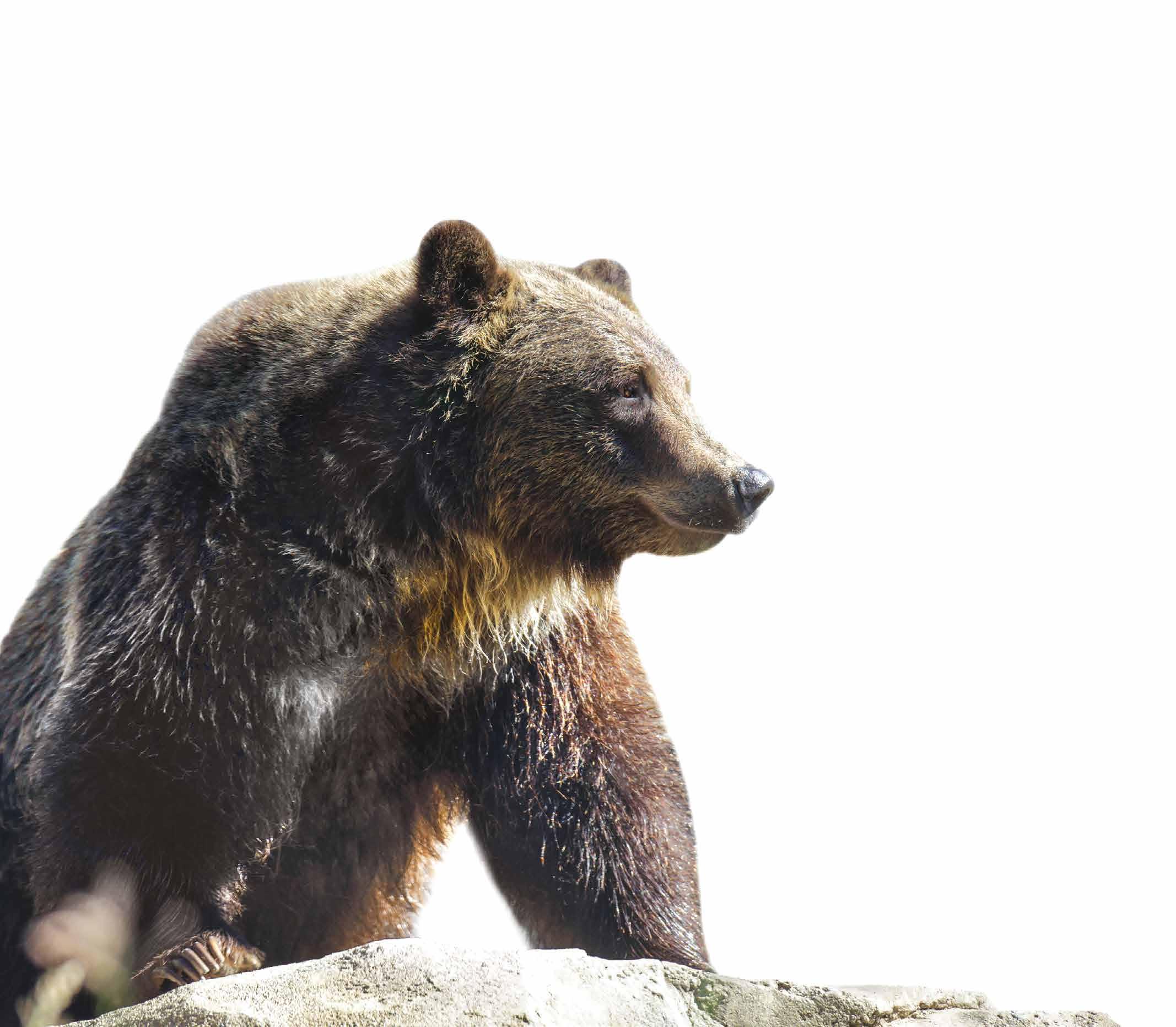
Vickie Johnson
Mr. Michael P. Koffman
Dennis K. Nakayama
Karen & John Newcomb
In Honor Of PEO Chapter KG
Abby Delawder
Howard Berger
Alex & Rachel Berger
Cindy Boddy
Liz Huff
Mr. & Mrs. Phil Callahan
Jean & Gary Hively
John Flotken
Shannon Hogan
Hope Goldberg
Ruth Schachter-Cohen
Linda Harris
Jill Schwimmer
Victoria & Michael Kelly
Grant Hickman
Judy Kouchoukos
Mrs. Ann Sullins
Carol B. Loeb
Mr. & Mrs. Eugene S. Kahn
Ms. Terry M. Lynford
Ms. Diane S. Rich
Merah
Jane Habbegger
Jo-Elle & Josh Mogerman
Michael & Carla Feuer
Jayne Ullstrom
Mrs. Marjorie M. Seldin
Mitch Weller
Shawn Gibbs
Elise Wilkinson
David & Ruth Ann Wilson
31 Fall 2023
Grizzly bear
Learn to Coexist with Snakes
See a snake near or around your home? Don’t panic! Most snakes are harmless, and all snakes deserve our respect. In Missouri there are more nonvenomous snakes than venomous. We only have ve kinds of venomous snakes in the entire state. Whether venomous or nonvenomous, they all play an integral role in the ecosystem and are excellent at controlling rodent populations; however, not all of us may want snakes near our house.
How can you decrease snake conflicts around your home?
In general, if you keep your yard tidy and remove locations where snakes can nd food (e.g., rodents) and shelter, snakes will have less of a reason to stay around your house. Here are some things you can do to decrease snake conflicts around your home:
Move Compost Area Away From Your House
Do you have boards, debris or trash lying around the yard? Clean it up! A board on the ground is a perfect hangout spot for a snake.
Remove Yard Debris Keep Your Grass Low
Control thick vegetation around your home as it can attract snakes as shelter and make it harder to see them.
Move Wood & Rock Piles Away From Your House
Wood piles and rock piles provide places for mice to live and snakes to use as shelter.
Compost can attract snakes as a protective shelter and as a food source. Piles of leaves and debris o er a welcoming canopy in which to hide, and food scraps can attract rodents for the snakes to feed on.
Learn About the Snakes in Your Area
The more you know about local snakes, the better you will be able to identify them. Scan the QR Code for additional information.

Pile of Rocks
Pile of Leaves
Watering Can
Sandbox
Lawn Mower
stlzoo 32
Respect Snakes
Snakes have been around for a very long time, and humans can coexist with them peacefully. Even if you move the following items farther away from your house, it does not guarantee you will never see a snake in your yard. If you do nd a snake, leave it be! Remember: The snake is more afraid of you than you are of it. Do not try to pick it up or move it. A er some time, it will move o on its own. A er observing a snake, you might nd that they are fascinating!
Help Identify the Things Around This Home that May Attract Snakes!
Whether you want snakes around your house or not, circle the items in the yard that may attract snakes.
 Tall Grass
Garden
Pile of Wood
Tall Grass
Garden
Pile of Wood
Answer Key: Pile of Leaves, Pile of Rocks, Compost Bin, Pile of Wood, Tall Grass 33 Fall 2023
Compost Bin
One Government Drive St. Louis, MO 63110
POSTMASTER: send address changes to stlzoo, Saint Louis Zoo, One Government Drive, St. Louis, MO 63110
C HECK IF APPROPRIATE:
Address Service Requested
© stlzoo, Saint Louis Zoo, 2023
Jumping Spiders
The jumping spider family alone outnumbers all the world’s mammal species with over 6,500 total.
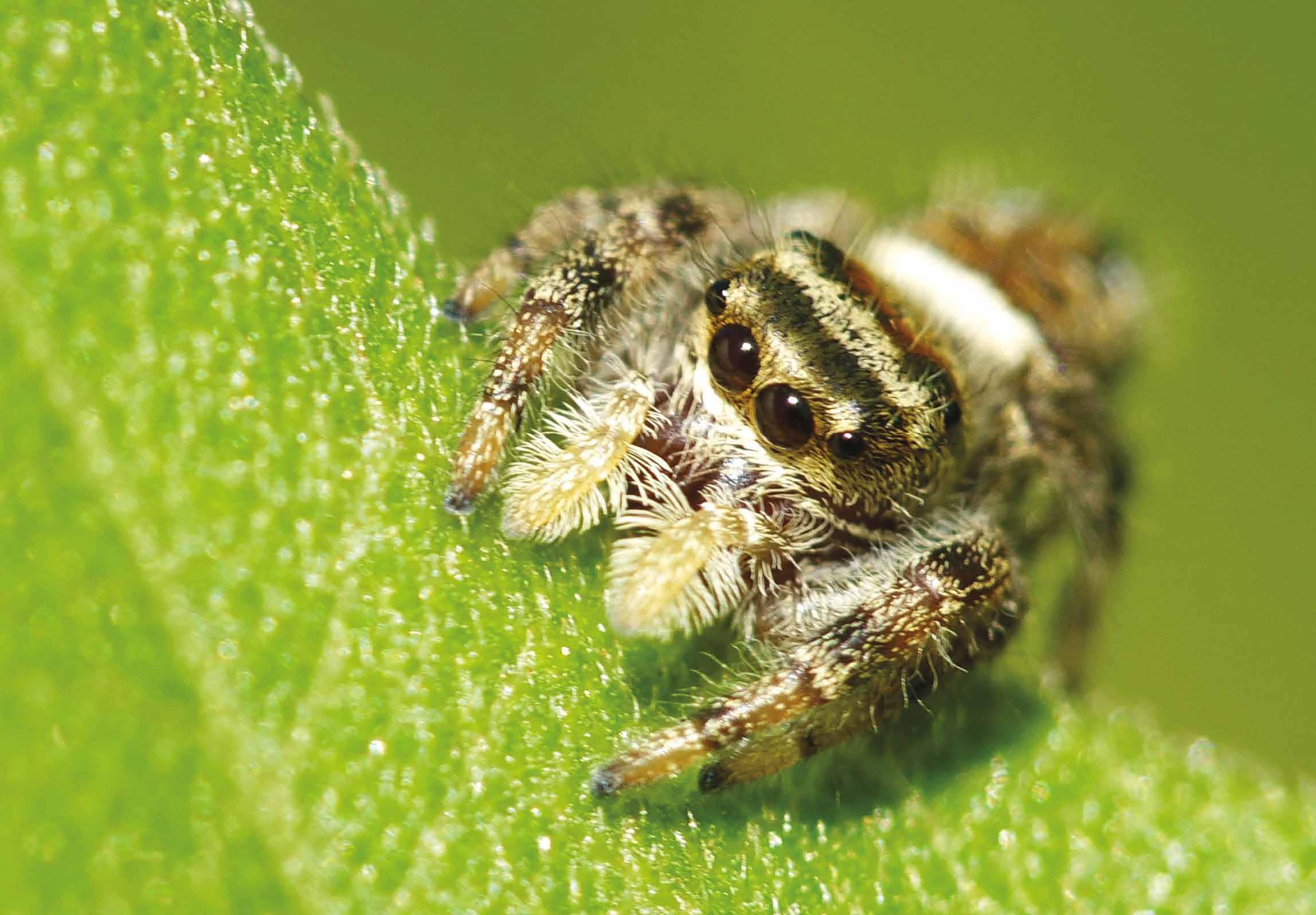
MY NAME IS MISSPELLED. MY ADDRESS IS INCORRECT.
clip this address panel and mail it to us, noting your request. Non-Profit Org. U.S. Postage P AID Saint Louis, MO Permit No. 2096
I RECEIVED MORE THAN ONE COPY. I NO LONGER WISH TO RECEIVE stlzoo Please
Photo by Ray Meibaum


















 By Regina Mossotti, Vice President, Animal Care
Photos by Roger Brandt and Ray Meibaum
By Regina Mossotti, Vice President, Animal Care
Photos by Roger Brandt and Ray Meibaum






 Above: Guests feed the giraffes; Below left: Guests visit the Saint Louis Zoo; Below right: Victoria crowned pigeon
Above: Guests feed the giraffes; Below left: Guests visit the Saint Louis Zoo; Below right: Victoria crowned pigeon

 PHOTOS BY RAY MEIBAUM AND JOELLEN TOLER
PHOTOS BY RAY MEIBAUM AND JOELLEN TOLER















 By Kayla Garcia, Zoological Manager, Invertebrates
By Kayla Garcia, Zoological Manager, Invertebrates











 By Hannah Stater, Partnership Marketing Coordinator
By Hannah Stater, Partnership Marketing Coordinator







 Tall Grass
Garden
Pile of Wood
Tall Grass
Garden
Pile of Wood
